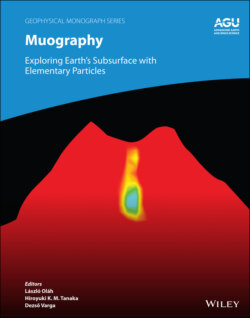Читать книгу Muography - Группа авторов - Страница 68
4.5 DISCUSSION
ОглавлениеVarious machine learning techniques were used to study the eruption forecasting performance of muography using data sets collected by the MWPC‐based Muography Observation System. The SVM and ANN models have achieved AUC scores that slightly exceed the value of 0.5. A convolutional neural network allowed us to extract the features of muographic images and achieved a moderated AUC score of 0.761. Although the MMOS achieved a better imaging resolution by a factor of 1.5 for daily muographic images, the AUC score of ROC metrics was only moderately improved with respect to the study conducted by Nomura et al. (2020). These results hint that further improvement of imaging resolution will be required to explore more features of muographic images and achieve more accurate forecasting. The ongoing enlargement of the MMOS system will allow us to improve the angular resolution of daily muographic images.
Figure 4.8 Receiver operating characteristic curve of convolutional neural network model is plotted for Minamidake crater (solid line), Showa crater (dashed line), and Surface region (dotted line). Circles show the optimal cutoff points of the ROC curves that are detailed in Table 4.1.
Concerning the processing of consecutive muographic images, a combination of CNN with a Long Short Term Memory network (Hochreiter & Schmidhuber, 1997) is expected to improve the current accuracy of volcano eruption forecasting with muography. The conceptualization of eruption forecasting with muography, both Nomura et al. (2020) and our study, set only one condition: that the occurrence of eruption is predicted for the eighth day using muographic images captured on previous seven consecutive days. The CNN model processed the images as a black‐box function; it is not clear how and why it worked and whether the prediction condition was optimal or not. The optimal time window and further forecasting conditions must be explored in future studies. Interpretable and explainable ML should be applied to find the hidden precursors of eruptions that cannot be found by conventional data analysis (Rudin, 2019).
Conceptually, interpretable ML is expected to improve the accuracy of volcano eruption prediction by means of incorporation of muographic data with seismic signals, ash emission rate, and ash column height data that are continuously recorded at the Sakurajima volcano by the Japan Meteorological Agency. However, it is questionable whether the environmental effects, e.g. the dependency of elevation of volcanic ash on the atmospheric temperature, can be taken into account in this approach. Furthermore, muography directly detects the mass movement beneath the active vents, thus it is expected that the muographic data will be better interpretable than seismic signals, ash emission rate, or ash column height data to the ML techniques. These questions will be investigated in future works.
The Sakurajima volcano has shown permanent activity during recent years, and SMO has acquired a sufficient amount of data for training machine learning models. In the case of volcanoes that erupt infrequently, it is not possible to acquire sufficient training data. It is an interesting question: whether the features extracted from muographic images of Sakurajima volcano can be applied to predict eruptions of other active volcanoes.
To conclude, machine learning‐based muographic image processing is a new approach that has already achieved moderate accuracy in forecasting vulcanian eruptions of the Minamidake crater of Sakurajima volcano. The improvement of this approach might allow us to explore and understand the hidden volcanic phenomena that occur before vulcanian eruptions. Due to the lack of large‐scale eruptions in data collected since 2018, we cannot conclude that the forecasting of future natural disasters, especially plinian type eruptions, will be possible with the current methods. Machine learning‐based processing of muographic images and data provided by conventional volcano observation techniques may contribute to a complex alarm triggering system for future prediction of short‐term volcano eruptions.
